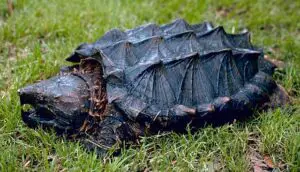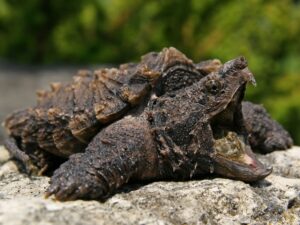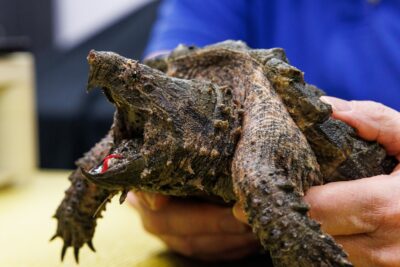Yes, snapping turtles do have teeth, but their dental structure is quite different from what you might typically associate with teeth. Instead of the sharp, visible teeth found in many other animals, snapping turtles possess a unique set of pointed, beak-like structures.
These sharp, horny projections around the jaws help them grip and tear their food, which primarily consists of aquatic prey and vegetation. So, while they don’t have conventional teeth, snapping turtles have specialized adaptations in their mouths to effectively catch and consume their diverse diet.
Do snapping turtles have teeth?

Snapping turtles do not have traditional teeth like mammals do, but they have a sharp, beak-like structure. Their jaws are powerful, and their beaks are well-adapted for cutting and crushing. The edges of the upper and lower jaws are serrated, which helps them grip and tear apart their prey.
It’s important to note that snapping turtles are carnivorous and opportunistic feeders, consuming a variety of prey such as fish, amphibians, insects, small mammals, and even carrion. Their strong jaws and sharp beaks make them effective predators in their aquatic habitats.
Types of Teeth in Snapping Turtles
Snapping turtles have a variety of tooth-like structures that serve different purposes in capturing and consuming prey. Here are the main types of “teeth” found in snapping turtles:
- Mandibular Beak: The snapping turtle’s most prominent “tooth” is its strong and sharp mandibular beak. This beak is made of keratin, the same substance found in human fingernails and hair. It is designed for cutting, tearing, and crushing the prey. The edges of the beak are often serrated, enhancing their ability to grip and process various types of food.
- Maxillary Beak: Similar to the mandibular beak, snapping turtles also have a maxillary beak on the upper jaw. This upper beak complements the lower one and aids in the shearing and tearing of prey.
- Vomerine Teeth: Inside the mouth of a snapping turtle, you can find small, pointed projections called vomerine teeth. These structures are located on the roof of the mouth and assist in holding onto slippery prey items.
It’s important to note that while these structures are often referred to as “teeth,” they are not true teeth like those found in mammals. Snapping turtles lack the continuously growing, rooted teeth that are characteristic of mammals. Instead, their beaks and associated structures are adaptations for their carnivorous diet and predatory lifestyle.
Function of Snapping Turtle Teeth

The teeth-like structures in snapping turtles serve various functions related to their carnivorous diet and hunting strategies:
- Capturing Prey: The sharp and powerful beak of snapping turtles is designed to seize and hold onto prey. They use their jaws to snap at and grab their victims, relying on the strength of their bite to secure the catch.
- Cutting and Tearing: The serrated edges of the beak aid in cutting and tearing apart the prey. Snapping turtles consume a wide range of prey, and their beaks help them process different types of food, from fish and amphibians to insects and small mammals.
- Crushing: Once the prey is captured, the powerful jaws of snapping turtles enable them to crush and break down the prey into smaller, more manageable pieces for consumption.
- Holding Prey Securely: The vomerine teeth on the roof of their mouth act as additional grips, helping to hold slippery prey in place while they tear it apart with their beaks.
These adaptations allow snapping turtles to be effective predators in their aquatic habitats, preying on a variety of animals. The structure of their “teeth” suits their lifestyle as ambush predators, lying in wait for prey to come close enough for them to strike quickly and decisively.
Common Prey for Snapping Turtles
Snapping turtles are opportunistic carnivores and have a varied diet that includes a wide range of prey. Their diet can depend on factors such as their size, age, and the specific habitat they inhabit. Common prey for snapping turtles include:
- Fish: Snapping turtles are skilled aquatic hunters and often consume various species of fish. They may ambush fish near the water’s edge or actively pursue them in the water.
- Amphibians: Turtles, especially younger ones, feed on amphibians like frogs, tadpoles, and salamanders. They are known to wait patiently for these prey items near the water.
- Insects: Snapping turtles feed on a variety of aquatic and terrestrial insects. They may snap at insects flying above the water or pick them off the surface.
- Crustaceans: Crayfish and other aquatic crustaceans are part of the snapping turtle’s diet. Their powerful jaws and beaks are well-suited for crushing the hard exoskeletons of crustaceans.
- Small Mammals: Larger snapping turtles may capture and consume small mammals such as mice, voles, and even small birds that come within reach.
- Reptiles: Snapping turtles may prey on smaller reptiles, including other turtles, snakes, and lizards.
- Carrion: While snapping turtles are primarily active hunters, they are also known to scavenge on carrion. They may consume the remains of dead animals they come across in their habitat.
Snapping turtles are opportunistic feeders and have a broad diet. Their ability to consume a wide variety of prey contributes to their success in diverse aquatic environments. As they age, snapping turtles tend to become more omnivorous, incorporating a greater variety of plant matter into their diet.
Interesting Facts about Snapping Turtle Teeth


